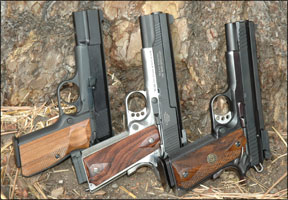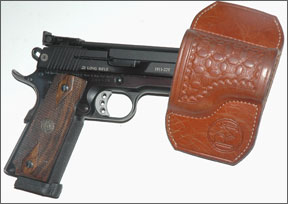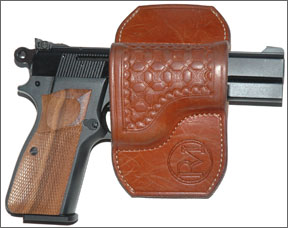Recently we reported on these pages the test results of Kimber’s and CZ’s 22 conversion units. The Kimber was for any 1911 and the Kadet was for the CZ 75. We like the versatility these units give the owner. There are quite a few other conversions around, and more seem to be added every month, with all makers reporting very brisk sales. The advantages of these conversions are obvious. For a fraction of the cost of another gun, or about what you’d expect to pay for a low-priced 22 auto, you can convert your main centerfire gun to shoot inexpensive 22 LR ammo. And it’s the same trigger pull used with centerfire ammo. Within a few hundred rounds the units pay for themselves in ammo costs saved. That’s why these conversions are all flying off dealers’ shelves.

This month we report on three additional units, one by J.A. Ciener of Cape Canaveral, Florida, for the Hi-Power, and two more for the 1911. One of these was by Advantage Arms in Valencia, California. The other was by Tactical Solutions out of Boise, Idaho. We note that Ciener also makes conversions for 1911s and for a host of other guns including Beretta 92/96, Para Ordnance P14, Taurus PT 92/99, and several Glocks as well as for AR-15s, Ruger Minis, and other semiauto and fully auto 223-caliber rifles. Advantage also makes ‘em for Glocks. Tactical Solutions makes a host of gun-related products, sight rails, stocks, AR-15 22 uppers, etc., and is gearing up to produce a 22 conversion for Glocks.
We tested the three units with the same three types of ammo as last time, which was Eley Pistol XTRA Target, Federal Classic RN, and Remington Yellow Jacket. We added CCI Mini Mag solids and Winchester 40-grain HP to the mix because one maker, Advantage Arms, specified that Federal ammo was a no-no in their unit. The other two makers, Ciener and Tactical Solutions, recommended high-velocity ammo, but noted that many types of 22 ammo might work, and the user could experiment to find the best type. We tested on a bitterly cold late March day, and because of the cold we overlooked a few failures to feed that could have been caused by near-frozen oil in the guns. But if a problem was obvious and repetitious we noted it. All the units worked extremely well, nearly perfectly, with one or another type of ammo. But there were some distinct problems. Here’s what we found.
Jonathan A. Ciener Hi-Power Plus, $249
Ciener makes two versions for the Hi-Power, our “Plus” with Millett adjustable sights, and a less expensive version ($199) with fixed sights. All are available in either black or silver, gloss or matte finish. Our test unit came in a fitted hard case with two magazines and succinct instructions how to disassemble the Hi-Power and install the conversion. The second magazine was an extra-cost item, which added $35 to the above price. We had no trouble installing our “gloss black” unit onto our Charles Daly Field HP. Ciener notes that this unit is not to be fitted to DA pistols.
The Ciener conversion was exceptionally well made. It would grace any Browning or other version of the Hi-Power, we thought, with its extremely nice metalwork and black finish. The finish was tasteful, mildly glossy, a bit more shiny than our matte-finished Daly, and complimented it nicely. With the Daly’s Kim Ahrends wood grips the 22 Daly HP was a very attractive firearm. The conversion’s slide and integral front sight were aluminum, with steel for the barrel and rear sight. The sight adjustments were fully functional and stayed in place. As it turned out, we didn’t have to move ’em.
We noted with glee the well-made Ciener magazines hold 14 rounds, and they were very easy to load—unlike the magazines from the other two makers in this test. With some ammo we got good enough function to have a full 15 shots viable. And this unit passed one significant test before any shooting: it fit our favorite holster, the Bachman Slide. The balance, or feel of the converted gun in the hand was exceptional. It felt just right to all our shooters. Also, the fully adjustable sight picture was excellent.
On the range we started with the Federal Classic ammo, and found it was extremely easy to load all 14 rounds into the beautiful magazine. These magazines, by the way, come apart very easily for cleaning. Not only does the bottom come off, the entire back plate slips out leaving the U-shaped channel of the magazine open for easy cleaning, certainly one of the best setup we’ve seen in auto-pistol magazines. A target came with the gun showing six shots in 4.5 inches, on a 50-foot target. We thought we’d be disappointed with that level of accuracy, but the Ciener conversion put all of the Federal rounds into 2.1 inches on average at 15 yards, and that was the worst average group we shot. Every type of ammo seemed to work well in the Ciener, though the light-recoiling Eley fodder didn’t always cycle the slide far enough to eject. All five-shot groups, with all ammunition, averaged just under 1.8 inches. Although the Ciener was generally in third place for accuracy, it was never by much. We thought it delivered at least adequate accuracy. Despite the cold weather, we had only four failures to feed total, and one of them was with 15 rounds in the gun. The slide didn’t pick up the second shot out of the full magazine. On a slightly warmer day, and with enough ammo through the unit to help wear it in, we could not get the Ciener to fail except with the Eley ammo. By design, the slide did not stay open after the last shot, a departure from the original Hi-Power setup.
Our Team Said: We were very impressed with the J.A. Ciener conversion. It looked good, was easy to use, performed adequately and reliably, and cost only $249 with one magazine. It would not cycle the Eley target ammo reliably, but the instructions called for high-velocity ammo, so that’s acceptable. The overall feel was excellent, and this conversion felt and looked like it belonged on our Daly frame. If you don’t need adjustable sights, you can save $50.
Though we give this unit a Gun Tests Grade A mark for quality and performance, we do have to report customer complaints about Ciener, and allow the reader to make his own judgment about how to proceed. We have had numerous complaints about J.A. Ciener not being responsive to customers. We verified that Mr. Ciener himself does not personally like to deal with customers, and we found out he has had equipment problems in the recent past. Currently Beretta conversions are delayed. He has only one office person who can handle phone calls some of the time. Ciener’s website does not reflect the fact that he no longer accepts orders for the AK-47 conversion. We learned that apparently very few, if any, AK-47 units have been delivered. We were told that if you have ordered one of those, your money will be sent back to you. However, one reader has received no response nor refund from the company in 2 1/2 years. It would seem that Mr. Ciener needs to raise his prices, hire more office help, get his website updated, and take customer relations a whole lot more seriously. We suggest you order with care. We have found Ciener’s products to be very good and competitively priced, but if the company can’t deliver, it makes no sense to try to buy them.
Advantage Arms, Inc., 1911-22T Target Conversion Unit, $350

This California-based company also has a Standard unit and has one coming for Commander models. These both retail for $275. As noted, Glocks are also one of this company’s conversion options. Our test unit came in a lockable, fitted, hard case with accessories of lube, cleaning rod, and a special cross-slide pin and wrench to fit the unit to our pistol. One polymer magazine came with the gun, but we were supplied with two more ($25 ea.). We chose our Fisher-Norinco 1911 45 for the test platform, and had no trouble attaching the Advantage unit to our gun. To install it we had to use the manufacturer’s slide-stop pin, and then screw the recoil rod down against the slide stop, using the wrench that came with the unit. We noted the slide seemed just a touch sticky in our tightened Fisher 1911 frame, although that frame handled the Kimber conversion perfectly.
The unit was fairly heavy, and unlike the Ciener unit had a slide that recoiled while the rest of the top—barrel and all—remained stationary. (The Standard and Commander units have fully recoiling slides.) It did not fit our Bachman Slide holster at all. The large, fully adjustable rear sight and the front dovetailed one were steel, as were the barrel, recoil rod, and slide-stop pin. The remainder was aluminum alloy. Workmanship and finish were excellent. The company name, a warning message, and various designations were tastefully marked in white on the slide. The top of the slide was serrated to cut glare. The backs of both front and rear sights were also lined to cut glare. In fact all three guns had glare-reduction serrations on the shooter’s-eye end of the sights. There was also an (extra-cost) optional rail provided with the Advantage unit that attached to the top by first removing two screws and removing the iron-sighted top. We chose to stick with the iron sights.
Advantage has done some extensive testing of what types of ammo work with their various units, and the results are displayed on the company website. The results may surprise you. Note that the company also uses three different spring weights to set up their different units for their intended use. It may be possible to alter your setup to work better with whatever ammo you might want to shoot. Our target setup had their heaviest spring. Note that the factory says dry firing the gun will damage the unit.
At the range we had the devil of a time loading the 10-round magazine, and the last two rounds were nearly impossible to get in with our frozen fingers. After our shooting tests we found a rod in the accessories box that would fit through a hole in the magazine follower and could be used to pull down the follower, making loading the mag a breeze. Yet nothing in the literature that came with the conversion mentioned that rod. That rod was steel, about a tenth of an inch in diameter and 3 inches long. While we liked that feature, we found the slim rod easy to misplace. If we had dropped it in the grass or snow we’d have surely lost it.
We started our testing with Advantage’s non-recommended Federal ammo and as the manufacturer said, it was a total loss. It would not eject nor feed. We thought the problems were from the too-tight slide, but as soon as we tried CCI Mini Mags, the gun worked much better, though not perfectly. We still had occasional failures to eject and feed, so after our main target session we mounted the unit on the unaltered Valtro frame used for the Tactical Solutions test. All the problems with slow cycling went away as soon as we changed the platform, although the Federal ammo still didn’t work. The problem is not that the Federal ammo is no good. In fact it’s some of the best made, in our experience. The various types of powder used in different brands of ammunition have different burn rates, resulting in vast differences in the degree of punch they give to cycle the pistol slide. Rifle powders, for instance, often burn much slower than pistol powders, resulting in an ineffective push by the time the bullet leaves a pistol barrel, though the velocity out of a rifle barrel might be much higher than with ammo designed for handgun usage. Match the impulse to the gun design and bango, everything works. Mismatched burning rates and slide masses don’t make for happy shooters.
Mounted on the Valtro frame, the Advantage Arms unit performed reliably, which illustrates what all makers state, that these units may not work perfectly with frames that have been altered. The reason is that the stack of tolerances under which all machines are made cannot be so loose as to accommodate any kind of fit, so the units are built to fit normal guns, not those which have been surgically altered.
With the Eley match ammo the Advantage Target lived up to its moniker. It got the smallest average groups of the test, 0.9 inch. If we owned this setup we’d be sure to try it with a whole bunch of target-type ammo to see what it could ultimately do.
We were not entirely happy with the Advantage Arms magazines, although as noted they loaded easily with the accessory rod. The mags worked reliably with the Valtro to hold the slide open after the last shot, but not with the Fisher-Norinco, but we thought that was acceptable.

Our Team Said: We liked the mass of the unit for its intended purpose, serious target shooting. In our opinion this would be a viable way to shoot your match 45 in rimfire NRA matches without giving up a whole lot to, say, a S&W Model 41 target pistol. And it costs a whole lot less than a Model 41. The need to use a wrench to mount it was a bit tricky, but we’d accept that if we were serious about using this for target shooting, especially if it delivered the goods. We thought the unit rated an A-, the minus for the hard-to-load magazines without that easily lost or forgotten accessory rod. We would not choose this unit for general field use. It didn’t fit our holster, was quite heavy, and was a bit fussy to mount for a day in the field. But the company’s Standard unit might be the way to go if you don’t demand precision target accuracy.
Tactical Solutions 2211 Conversion, $460
Yep, this one is a bit on the costly side. Why? First, it’s made largely of 4140 steel. Second, the design permits unlimited dry firing. The magazines are milled from solid aluminum blocks, and they hold the slide open after the last shot. Each extra magazine lists for $75. This unit will fit all full-size and Commander-length frames. There are fiber-optic sight upgrades if you need or want them, and you can also get a Picatinny rail, or a combo setup with both the sight rail and the adjustable-sighted rail. All are matte-blue finished. Like the Advantage Arms Target setup the slide moves and the barrel stays put. The movement of the slide was extremely slick. The sights were a fully adjustable rear (Kensight, similar to Bo-Mar), and the front was dovetailed in from the front and retained with a screw, a really professional setup that allows easy replacement if it’s damaged, or easy change to fiber optics. Oddly there were no identifying marks on the slide anywhere, though the magazine bottom carried the company logo.
Workmanship was excellent, especially inside where it counts. We chose the Valtro for our test frame. Fitting the TacSol unit to our Valtro was very easy. It was bulky but not too heavy, and it fit our Bachman Slide holster easily. We also mounted this unit on a Colt CCO, which has an alloy Officer’s-size frame with a Commander-length slide. It fit easily and worked perfectly, but felt top heavy due to the light frame. The magazine stuck out, but worked fine.
The company recommends shooting 500 rounds through the unit to properly mate the rubbing parts. We did not do that but fired enough to know that it was already quite reliable. The unit would not reliably cycle the Eley target ammo, but worked well with everything else. We had one failure to feed with Remington’s Yellow Jacket ammo, which has an odd bullet shape.
The TacSol unit was, on average, not quite as accurate as the Advantage Target, but better than the Ciener. We suspect that for longevity this mostly steel unit might beat out the others, but a lot depends on care and handling. This unit was on the heavy side for field carry, but would be fine for training with a full-size 1911 because of that weight.
Throughout the test session we were constantly impressed by the feeling of precision this unit had. The slide cycled notably slower than the other two. We kept looking at it after a firing session and wondering just exactly what had gone so right. It was easy to fit to the gun, and the magazine was at least tolerably easy to load, but not as easy as that of the Ciener Hi-Power Plus. The magazine could be disassembled easily.
Our Team Said: We were not entirely happy with the price, and that caused us to downgrade it slightly. The CZ Kadet was in this same price ballpark, but it had tritium sights and delivered similar accuracy. We’re not sure you need steel slide construction for such a unit, but if you want the solid feel it gives, this Tactical Solutions 2211 conversion might be right for you. Be advised the look of the converted gun ends up not being pure 1911, and that might bother some folks, but it sure did work well. We gave this a B+, largely because you can get similar performance for a lot less money from Ciener and better accuracy for less money with the Advantage Arms unit.
0610-22-CONVERSIONS-ACCURACY.pdf





























